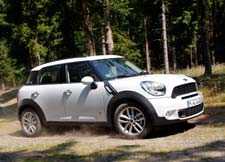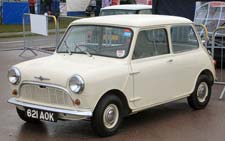Small cars were nothing new in the late 1950s. After WWII, gas was in short supply in Europe, and many manufacturers came out with "microcars" based on tiny motorcycle-sized engines. They achieved outstanding mileage at the expense of pretty much everything else. Most were cramped, stark little tin boxes that turned into portable saunas in summer and refrigerators in winter. They were noisy enough to dull your hearing and so slow they were easy prey for marauding Moped gangs. The Mini was designed to take them on in the marketplace.
Alec Issigonis was a certified engineering genius with a dour disposition and a passion for finding new ways to do things. He had previously designed the Morris Minor, a sales success for British Motor Corporation (BMC), the company that made Morris, Austin, Austin-Healey, MG and several others in England. Issigonis was challenged to produce a car four feet wide by four feet high and 10 feet long that would seat four adults in comfort and take their luggage to boot. His new design was intended to be more comfortable and practical than the microcars, but by the time it came out they were already starting to be replaced in the English market by small sedans from Ford of England, Renault, Volkswagen and Fiat. The Mini would have to take on much better engineered foes than the primitive microcars had been.
In order to keep the car as short as possible, Issigonis opted to turn the engine sideways, stuff the gearbox underneath and drive the front wheels. The original engine was 848cc producing 34 BHP and in 1963 the “S” version engine was increased to 997cc which upped the BHP to 55. This approach was unusual at the time, but has since become the most common configuration for small cars. The unibody was very strong, and steel subframes at the front and rear carried the running gear and suspension. The fully independent suspension had rubber donuts in place of springs, and the tiny drum brakes rode inside 10-inch diameter wheels.
The Mini weighed only 1,300 pounds, which contributed to its excellent gas mileage. Although it looked tiny and at ten feet long it was tiny, the interior was surprisingly roomy, with plenty of space for six footers in front. In addition, the passenger space in the car had to comprise 60 percent of the length of the vehicle. The small grille across the front was shaped in a permanent frown but the overall effect was cute and personable. Like the VW Bug before it, the Mini was about to become a "cult car." The first models on the market were called Austin Sevens, followed by a Morris version, the Mini Minor. Soon all models were simply called Minis. In 1976 while working at Hoag Hospital in Newport Beach, CA, I worked with Kelly, she and her husband were serious ralley fans and attended Mini Cooper ralleys several times a month. They would get up to 50 cars in a group and spend the day driving all over southern California.
Today the MINI is far more luxurious, handles better and is much faster and is even offered in a 4 door configuration. The Cooper S Countryman for 2011 is available in all wheel drive with a 1.6 liter turbocharged inline 4 cylinder engine producing 180 BHP and mated to a 6 speed transmission and is rated around 32 MPG. They also make a diesel model that gets 64-72 MPG but as of this writing there are no plans for import into the USA. |
















